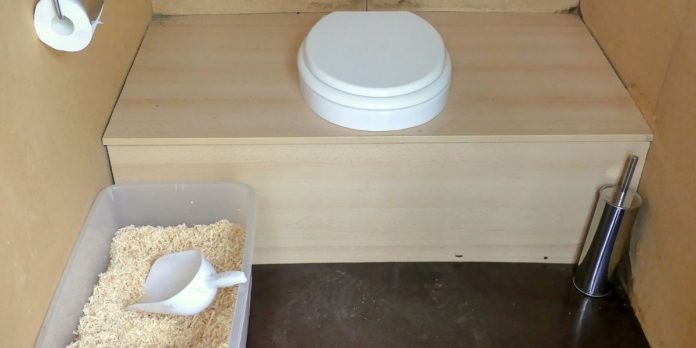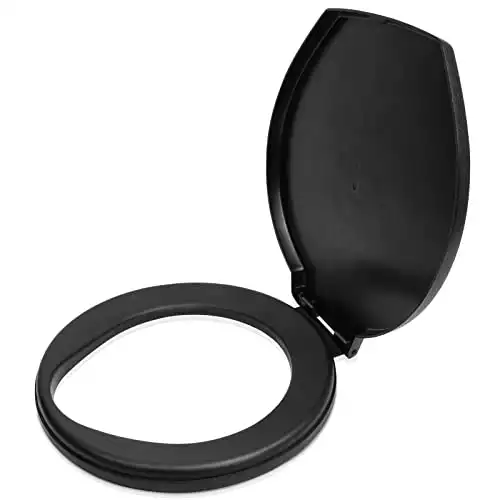Your first concern when you go off the grid is likely to be getting food and water, but once you’ve accomplished that you’ll be left with another, potentially smelly, problem. That is where to go when you really need to go!
The perfect loo for you and your situation will depend on several factors. These factors include whether you have a rural property or an urban one, how much you’re looking to spend, and how long you anticipate you will need your off-grid toilet.
With that in mind, here are several options that could work well in a variety of setups.
What Is an Off-Grid Toilet?
For a toilet to be considered off grid it must not be hooked up to municipal services. This means no electricity from the grid but also no municipal water or sewer either. Some properties might not have these services available or they might not be available during a prolonged emergency.
Many people don’t realize that municipal water supplies usually rely on pumps to deliver water to homes. The city’s backup power might also fail in extraordinary circumstances, such as a hurricane. For natural disasters that include overland flooding, municipal sewer systems can be overwhelmed and unavailable.
Solid human waste is not only unpleasant but is also considered a biohazard.
If you want to be prepared to survive for any period of time, you will need a plan to deal with the waste you and your family produce.
Unfortunately, there is not one solution that will suit the needs of every home. Your available space, alternate water supply, climate, and budget are all factors in the right choice for you.
Let’s look at our options.
1. Septic System
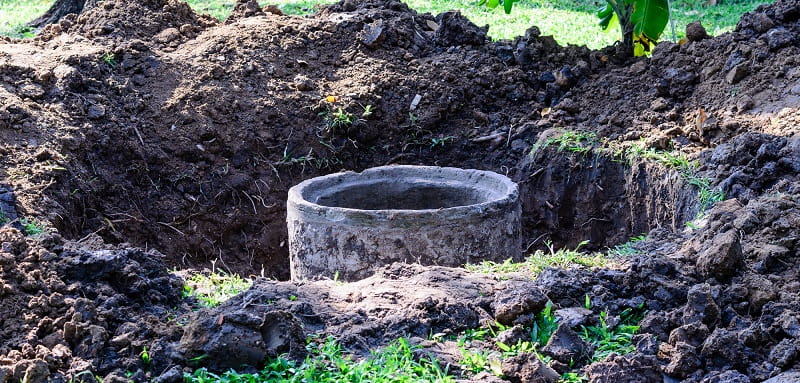
A septic system is the most common type of waste management for homes not connected to the municipal sewer system. And while many homes with septic systems aren’t technically off grid, it’s still an option for off-grid living.
There are many designs and combinations for different septic systems, but almost all of them rely on a settling tank and drainage field.
I could talk about septic systems all day, but here is the short version.
Waste first goes into the settling tank with one or more chambers. Once in the tank, solids move to the bottom to break down further, and liquids rise to the top. The liquid then runs from the top of the tank out to a drainage field, where gravel, sand, or peat moss filters the liquid back into clean water.
Most homes with wells do rely on an electric pump to move water into the home, but they don’t have to. Some lots with a natural slope allow for gravity to do the work of the water pump. Without electricity, you can also gather water either from the well or another source and pour it directly into the toilet to make it flush.
Pros:
- You might already have an off-grid toilet
- Long-term costs are low
- Only needs to be pumped out every 3–5 years
Cons:
- High upfront cost
- Can’t be installed everywhere
- Larger lot size required
Composting Toilet
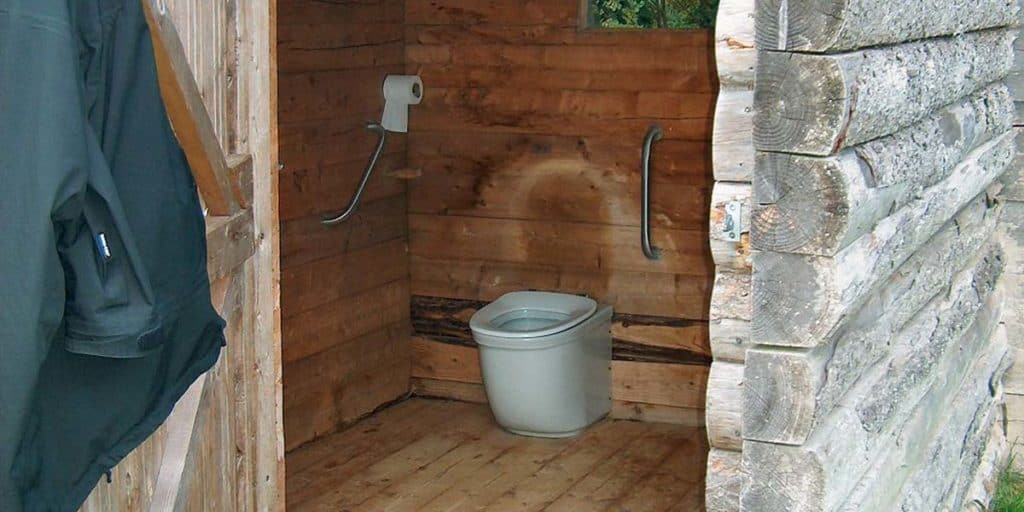
Composting toilets are one of the very best options for doing your off-grid business. They take human waste and break it down into rich organic compost.
Read: How does a composting toilet work?
The best models divert urine through a small drain pipe outside. Each time you produce solid waste you add dry cover material to the toilet and turn the chamber to ensure aeration.
Composting toilets shouldn’t produce odors under normal use in warm temperatures. Some brands do perform better than others, so check out our guide to the best off grid composting toilets before investing.
Pros:
- Should not smell
- Cost effective
- Produces fertile compost
Cons:
- Must be used in a warm space
- Requires other compostable material
Bucket Toilet
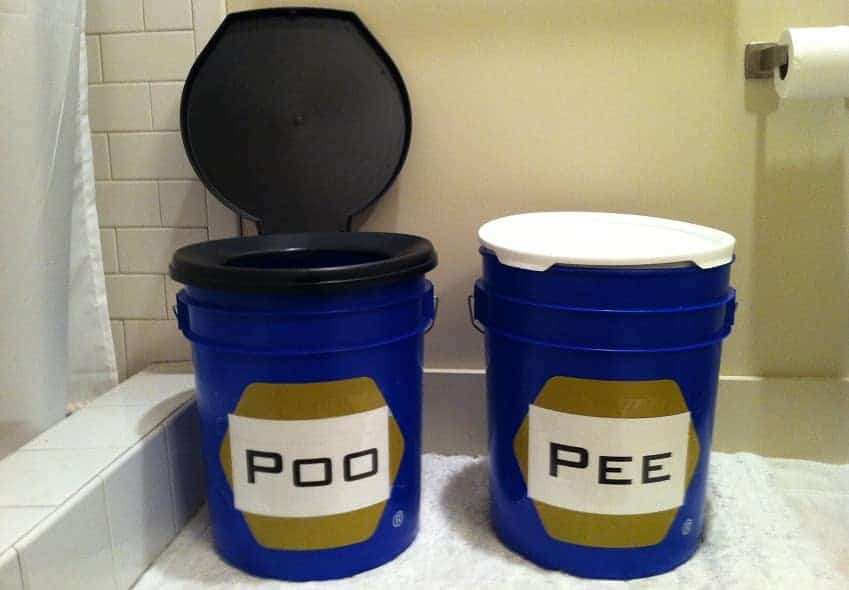
In a short-term emergency, there isn’t a much better option than a couple of bucket toilets in the garage for most people.
Essentially a bucket toilet is two buckets with seats, you can read more about bucket toilet systems here; essentially, it is two buckets with seats. Do invest in purpose-built bucket seats as they stay put and form a tight seal.
The pee bucket doesn’t need a liner, just make sure there are no holes, and you can drain onto your property.
The poo bucket should have a bag as a liner for disposing of waste. Solid waste can be incinerated, composted, or buried. You can also dispose of it as you normally would once your emergency situation is over and normal services have resumed.
Line your poo bucket with plastic bags or compostable liners and dispose of solids after every use. You can buy compostable bags online and in bulk if you plan to compost your solid waste.
Pros:
- Super affordable
- Easy to set up
Cons:
- Not a great long-term solution
- Disposal can be difficult
Chemical Toilet
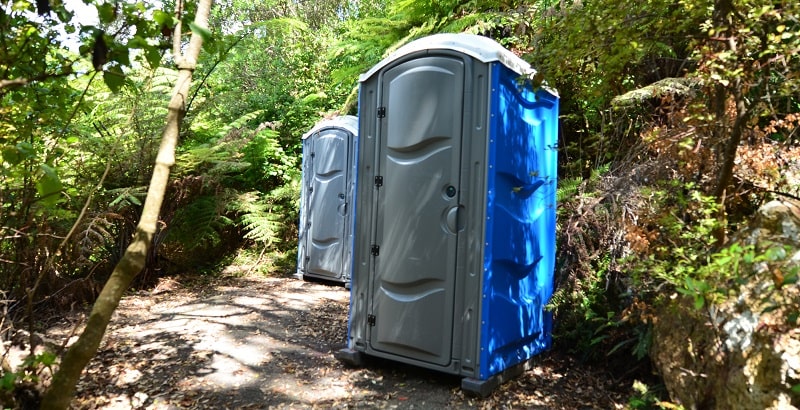
The chemical toilet we are most familiar with is probably the often maligned porta-potty you get to use at public events or on construction sites. Several manufacturers make smaller versions for home use as well.
All chemical toilets use a blue chemical solution waste falls into. The chemicals in that solution serve a few functions.
- Breaks down waste and eliminates odors: It usually has a smell of its own to disguise less desirable smells
- Indicate when the chemicals need to be replenished: When the color changes from blue to green, it’s time to clean it out.
If you plan on using a chemical toilet as your off-grid toilet, you will need to have it pumped out regularly or store waste somewhere for future disposal.
Check with your local waste disposal authority to find out how to dispose of the used solution where you live.
Pros:
- Low up-front and continuing costs
- Portable
- Possible to stockpile chemicals
Cons:
Dry-Flush Toilet
Dry-flush toilets are an off-grid toilet option that have some major similarities to a bucket toilet. It’s essentially a portable toilet that uses rolls of specifically designed bags to contain the waste.
When you “flush” a dry toilet, the bag inside twists shut, creating an air-tight and odorless seal. The sealing process does take a small amount of power, which can be supplied by a 12-volt battery or solar panel.
While the toilet is fairly inexpensive, the bags are about $1 per use. You also have to find a way to dispose of all the waste-filled plastic bags.
Given the cost and the ongoing need for bags, it’s not that much better than a bucket toilet. Though I could make a good case for a dry-flush toilet on a boat not equipped with a head or other specialized applications.
Pros:
- Low up-front cost
- Odorless and portable
Cons:
- Ongoing need for bag cartridges
- High cost per use
- Left with many plastic waste-filled bags
Latrine/Outhouse
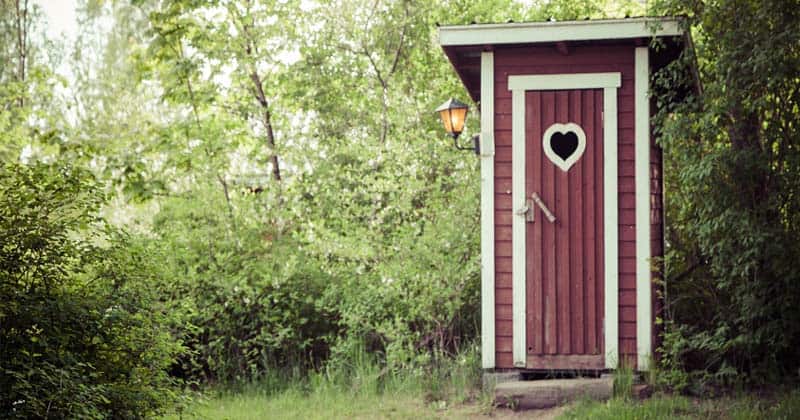
You may have used a latrine or outhouse a time or two in your life. Even though I haven’t fully recovered from the outhouses at Girl Guides camp as a child, they are still a welcome sight at the beaches I pass on my long training runs.
Latrines are essentially a hole in the ground with a shelter and seat to do your business. If you have the space on your property, a latrine can still be a good simple option for a long-term off-grid toilet.
You can construct your own by digging a hole that sits above the water table and flood level.
Make sure you dig your latrine downhill and far away from your water source.
Latrines can work in conjunction with a composting toilet that is too cool to keep up in winter.
A word from the experts: when it’s cold, store your seat inside and bring it out to the latrine with you when you go. Latrines can also work well as a backup to more temperamental systems.
Pros:
- Simple
- Reliable
- Affordable
- Long-term solution
Cons:
- Not as pleasant as other options
- Outdoors
Camping Toilet
Camping toilets usually aren’t the best choice for an off-grid toilet. In most cases, you’ll be happier and spend less with just a simple bucket toilet. Camping toilets are essentially grown-up potties, and waste falls into a chamber where you get to clean it out later. Yuck!
Pros:
Cons:
- Small mixed chamber
- Unpleasant to clean
Incinerating Toilet
For long-term use, installing an incinerating toilet is the way to go. Waste is incinerated within the toilet at high temperatures using either electricity or gas.
Gas-powered incinerating toilets require a small amount of electricity, which can be supplied using a small solar panel in the bathroom. Incinerating toilets must work in conjunction with an installed vent supplied by the manufacturer.
A typical user can expect their waste to generate about a cup of ash per week.
Pros:
- Odorless
- Small footprint
- Can be used at any temperature
Cons:
- Very expensive
- Requires gas and or electricity supply
Separating Tank Toilets
Separating tank toilets are essentially permanent camping toilets with one major difference. Tank toilets separate solid wastes from urine, which dramatically cuts down on smell.
They are designed to work in conjunction with a small fan and vent to further reduce odors in the space. The fan is small enough that it can work on a small solar panel in the bathroom window. Separating tank toilets can be hooked up to an existing plumbing vent or a vent supplied by the manufacturer.
Once separated, waste does have to be removed from the toilet. Urine can be drained to a small tank or leaching field outside the home or treated and used as fertilizer.
Solids fall into a collection chamber and can either be composted or incinerated once removed. Separating toilets can be installed in almost any location and used at any temperature.
Pros:
- Cost effective
- Can be used in cold locations
- No need to add material to the waste
Cons:
- You have to clean out waste
Picking the Right Off-Grid Toilet for You
It’s important to have a waste-management plan in case of an emergency.
Think about what emergencies are most likely to occur where you are. For example, if your area might experience deep flooding, your only option might be one that works on the top floor of your house. When planning for your off-grid family throne, consider the following:
- How long do you plan to use it
- The most likely reason for the emergency
- The climate in your location
- What municipal services are likely to still work
- Number of users
- The temperature of the location
- Budget
- Ongoing need for consumable supplies
Some of these options, like septic systems, composting toilets, latrines, and incinerating toilets, are viable as permanent everyday solutions for off-grid toilets.
Others, like bucket toilets and camping toilets, are budget-friendly solutions for short-term emergencies. Some of these options, such as dry flush toilets and separating toilets, might only be acceptable for occasional use in far-flung locations.

